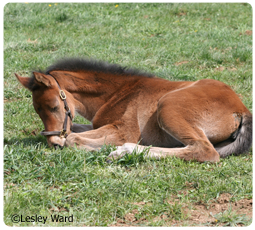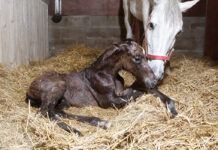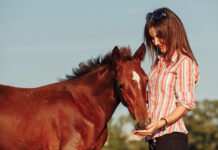
Should tragedy strike, would you know how to raise an orphan foal? Learn the basics, so you’re prepared and hopefully, you’ll never find yourself in this situation.
Most orphans transition easily to an alternative milk source, but it’s crucial you use a horse-specific milk replacer. A “multi-species” milk replacer meant for calves, goats, sheep, etc. is NOT appropriate for foals.
“There are several reputable brands and to some extent you get what you pay for, so don’t necessarily buy the cheapest one. We use Land o’ Lakes Mares Match at the University of Florida,” says Martha Mallicote, DVM, DACVIM, Clinical Assistant Professor of Large Animal Medicine at the school, which is located in Gainesville.
“It is of the utmost importance that the milk be made up according to the instructions on the package. Don’t try to ‘stretch’ the replacer by adding extra water or make it more concentrated so the foal has to eat less. Milk replacers are designed to be fed as labeled. Deadly electrolyte abnormalities can result from improperly mixed milk.”
You’ll need to do some easy math to figure out how much milk replacer to feed, and that involves determining approximately how much the foal weighs.
“Foals normally suckle between 20 to 25% of their body weight every day from their dam. We calculate what they should be eating and then shoot for them to take in at least 20%,” explains Dr. Mallicote. “It is important to reweigh and recalculate as the foal grows. Up until two to three weeks of age, try to feed every two to three hours. After that, feedings can be stretched out to four-hour intervals and the foal can be introduced to hay/grain to help fill the time gaps.”
Dr. Mallicote strongly recommends feeding from a bucket, never a bottle. With a bottle, the foal can aspirate milk into the lungs and get pneumonia, which can be deadly serious.
“Orphan foals are already predisposed to being bratty and disrespectful to people. Feeding via a bottle only encourages this behavior, as they associate humans with food,” she adds. “Hanging the milk replacer bucket and walking away helps disconnect those two things.”
It helps if the foal is hungry the first time you introduce a bucket. Many foals will be curious to try the milk replacer and take to it readily. If the foal needs encouragement, dip your hand (wash it first!) into the replacer and use your fingers to entice the foal to start drinking.
Don’t try to save time by mixing up too much milk ahead of time.
“Once milk replacer is mixed up it has a short ‘shelf life’ when hanging in the stall, especially in hot climates. Even once the foal is fully on bucket feedings, the rations still have to be made fresh and offered very frequently,” cautions Dr. Mallicote. “You cannot just hang a day’s worth of milk and leave the foal to drink it at his leisure.”
As soon as the foal is two weeks old, begin offering a grain formulated for young, growing horses, along with high quality hay and/or grass.
“Once the foal is interested and willing to consume grain and hay, the volume of these feeds can be increased and the milk can be tapered back,” Dr. Mallicote says. “Many owners find that they can completely wean the foal from milk by six to eight weeks of age, as long as the foal will eat adequate amounts of grain and hay. Introducing other feed sources makes it safer and easier to decrease the frequency of milk replacer feedings.”
(Caution: don’t overfeed grain! As a rule of thumb, foals shouldn’t eat more than one pound a day per month of age, so a one-month-old foal shouldn’t get more than one pound per day, unless your veterinarian says otherwise.)
If the young foal’s dam was alive, it would be normal for him to ingest some of her feces. Veterinarians believe this introduces good bacteria to colonize the foal’s gastrointestinal tract to help with digestion.
“If the orphan is being housed alone, he should be given access to some feces from an adult horse in the stall or paddock,” notes Dr. Mallicote. “This is most important in the first few weeks, but they do continue to eat their dam’s feces through the first months of life.”
You probably have a friend whose spoiled children make getting together less than pleasant. No one enjoys bratty kids or a spoiled rotten horse. Without the foal’s dam around to instill a certain amount of discipline and respect, many people unwittingly spoil an orphan foal, simply because they aren’t thinking of the consequences down the road. The adorable young foal who puts his front feet on your shoulders will be truly dangerous a year from now.
“The biggest mistake I see with orphan foals is related to their behavior. It is too tempting for owners—especially after the foal’s mother dies and it is all alone—to allow these foals to ‘play’ with them and not act respectfully. Don’t let your orphan foal do anything that you would not allow a yearling colt to do—no kicking or biting people, no rearing and no disrespect. It seems cute when they weigh 100 pounds but not when they weigh 1000 pounds,” advises Dr. Mallicote.
“Some owners get a nurse mare for the orphaned foal, which can provide that ‘motherly influence,’ in addition to feeding the foal. However, even an old retired broodmare or patient older gelding can be a good companion to an orphan foal. These companions may not feed the foal, but they will provide some guidance on how to fit into the equine social hierarchy.”
Further Reading
Orphan Foal Critical Care







Great advice.
Wow. Very excellent advice. However, I’m quite confused by the information in this article and info given in the article entitled, ‘Orphan Foal Critical Care’, linked just beneath.
Has anyone else noticed the opposing views given by each of these? One says to never bottle-feed (and why) while the other assumes you would never feed any other way. One states feed a mare’s replacement formula only, the other says that cow’s milk mixed w/honey is acceptable.
IMO, someone associated with this site needs to figure out which of these is right (or which is at least MOST correct) and pull the other article!